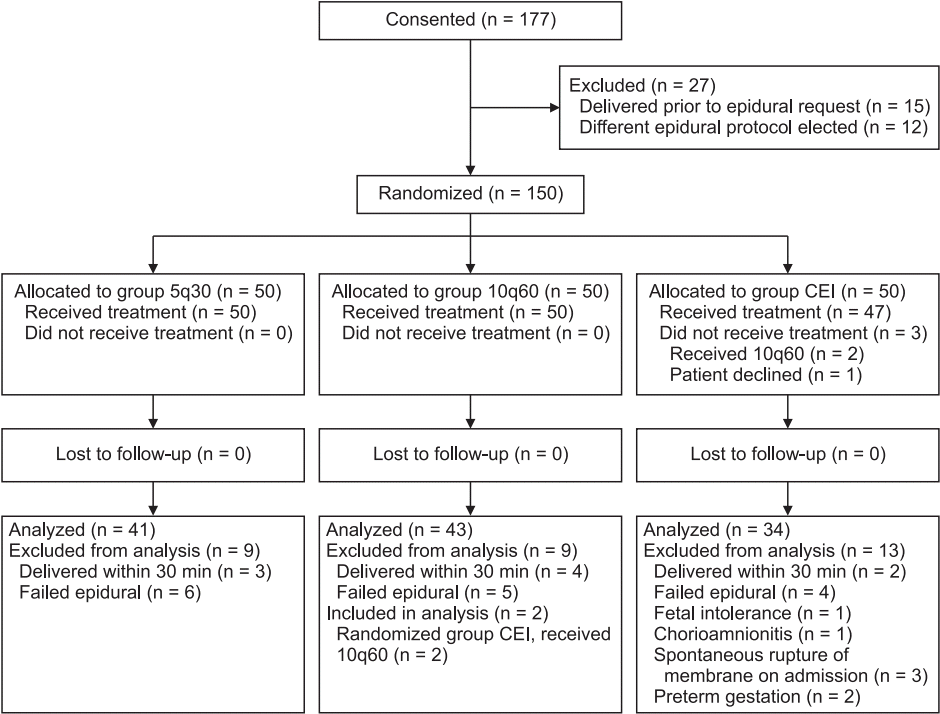1. Carvalho B, George RB, Cobb B, McKenzie C, Riley ET. Implementation of programmed intermittent epidural bolus for the maintenance of labor analgesia. Anesth Analg. 2016; 123:965–71.

2. Kaynar AM, Shankar KB. Epidural infusion: continuous or bolus? Anesth Analg. 1999; 89:534.
3. Riley ET, Carvalho B. Programmed intermittent epidural boluses (PIEB) for maintenance of labor analgesia: a superior technique to continuous epidural infusion? Turk J Anaesthesiol Reanim. 2017; 45:65–6.

4. Munro A, George RB. Programmed intermittent epidural boluses (PIEB): a superior technique for maitenance of labor analgesia. Turk J Anaesthesiol Reanim. 2017; 45:67–9.

5. Carvalho B, Riley ET. Programmed intermittent epidural boluses (PIEB) for maintenance of labor analgesia: an incremental step before the next paradigm shift? Turk J Anaesthesiol Reanim. 2017; 45:73–5.

6. Munro A, George RB. Programmed intermittent epidural boluses (PIEB) for maintenance of labor analgesia: a superior technique and easy to implement. Turk J Anaesthesiol Reanim. 2017; 45:70–2.

7. Sng BL, Zeng Y, de Souza NN, Leong WL, Oh TT, Siddiqui FJ, et al. Automated mandatory bolus versus basal infusion for maintenance of epidural analgesia in labour. Cochrane Database Syst Rev. 2018; 5:CD011344.

8. George RB, Allen TK, Habib AS. Intermittent epidural bolus compared with continuous epidural infusions for labor analgesia: a systematic review and meta-analysis. Anesth Analg. 2013; 116:133–44.
9. Wong CA, McCarthy RJ, Hewlett B. The effect of manipulation of the programmed intermittent bolus time interval and injection volume on total drug use for labor epidural analgesia: a randomized controlled trial. Anesth Analg. 2011; 112:904–11.
10. Wong CA, Ratliff JT, Sullivan JT, Scavone BM, Toledo P, McCarthy RJ. A randomized comparison of programmed intermittent epidural bolus with continuous epidural infusion for labor analgesia. Anesth Analg. 2006; 102:904–9.

11. Bullingham A, Liang S, Edmonds E, Mathur S, Sharma S. Continuous epidural infusion vs programmed intermittent epidural bolus for labour analgesia: a prospective, controlled, before-and-after cohort study of labour outcomes. Br J Anaesth. 2018; 121:432–7.

12. Capogna G, Camorcia M, Stirparo S, Farcomeni A. Programmed intermittent epidural bolus versus continuous epidural infusion for labor analgesia: the effects on maternal motor function and labor outcome. A randomized double-blind study in nulliparous women. Anesth Analg. 2011; 113:826–31.
13. Tien M, Allen TK, Mauritz A, Habib AS. A retrospective comparison of programmed intermittent epidural bolus with continuous epidural infusion for maintenance of labor analgesia. Curr Med Res Opin. 2016; 32:1435–40.

14. McKenzie CP, Cobb B, Riley ET, Carvalho B. Programmed intermittent epidural boluses for maintenance of labor analgesia: an impact study. Int J Obstet Anesth. 2016; 26:32–8.

15. Breivik H, Borchgrevink PC, Allen SM, Rosseland LA, Romundstad L, Hals EK, et al. Assessment of pain. Br J Anaesth. 2008; 101:17–24.

16. Bromage PR. A comparison of the hydrochloride and carbon dioxide salts of lidocaine and prilocaine in epidural analgesia. Acta Anaesthesiol Scand Suppl. 1965; 16:55–69.

17. Epsztein Kanczuk M, Barrett NM, Arzola C, Downey K, Ye XY, Carvalho JC. Programmed intermittent epidural bolus for labor analgesia during first stage of labor: a biased-coin up-and-down sequential allocation trial to determine the optimum interval time between boluses of a fixed volume of 10 ml of bupivacaine 0.0625% with fentanyl 2 μg/ml. Anesth Analg. 2017; 124:537–41.
18. Zakus P, Arzola C, Bittencourt R, Downey K, Ye XY, Carvalho JC. Determination of the optimal programmed intermittent epidural bolus volume of bupivacaine 0.0625% with fentanyl 2 μg.ml-1 at a fixed interval of forty minutes: a biased coin up-and-down sequential allocation trial. Anaesthesia. 2018; 73:459–65.

19. Graham AC, McClure JH. Quantitative assessment of motor block in labouring women receiving epidural analgesia. Anaesthesia. 2001; 56:470–6.

20. Halpern SH, Carvalho B. Patient-controlled epidural analgesia for labor. Anesth Analg. 2009; 108:921–8.
21. Xu J, Zhou J, Xiao H, Pan S, Liu J, Shang Y, et al. A systematic review and meta-analysis comparing programmed intermittent bolus and continuous infusion as the background infusion for parturient-controlled epidural analgesia. Sci Rep. 2019; 9:2583.





 PDF
PDF Citation
Citation Print
Print




 XML Download
XML Download